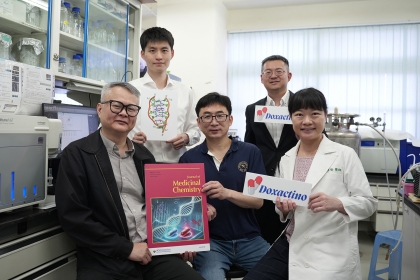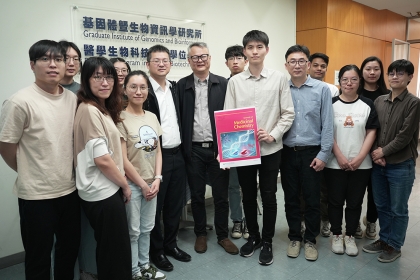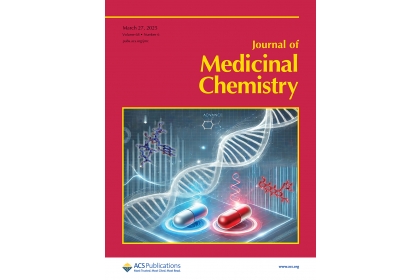Doxactino: A New Era in Triple-Negative Breast Cancer Treatment with Dual DNA Intercalator
2025-05-08
興新聞張貼者
Unit秘書室
1,070
Innovative therapy "Doxactino" featured on the cover of Journal of Medicinal Chemistry, offering new hope for clinical cancer treatment
Breast cancer remains the most common malignant tumor among women worldwide, and ranks first in both incidence and mortality among Taiwanese women. According to the latest data from Taiwan's National Health Administration, the age-standardized incidence rate of breast cancer in women is 69.1 per 100,000 people, and the mortality rate is 12.0. On average, 31 women are diagnosed with breast cancer in Taiwan every day, and 6 die from it. Among them, triple-negative breast cancer (TNBC) accounts for about 15%. It poses the greatest challenge to clinical practice due to the lack of effective targeted therapy, rapid progression, high metastatic potential and poor prognosis.
To overcome the limitations of current treatments, the research team of Professor Ming-Hon Hou from the Graduate Institute of Genomics and Bioinformatics at National Chung Hsing University has developed an innovative combination therapy using two small-molecule DNA intercalators. This approach shows great therapeutic potential for TNBC. This breakthrough was published in the internationally renowned journal Medicinal Chemistry in March 2025 and was selected as the cover article of the journal, indicating its significant contribution in the field of cancer targeted therapy. The new therapy has been registered as the trademark "Doxactino", highlighting the synergistic mechanism and clinical relevance of the combination of doxorubicin and actinomycin D.
The research was conducted by Professor Hou in collaboration with Dr. Chi-Chien Lin of the Institute of Biomedical Science and Dr. Tai-Lin Chen of Post Baccalaureate Medicine, School of Medicine, at NCHU. The project also involves international collaboration with Professor Stephen Neidle, a leading authority on medicinal chemistry at University College London (UCL), demonstrating a strong interdisciplinary and multinational partnership.
Innovative Mechanism: Dual Intercalator Synergy Suppresses EGFR Expression
The research team addressed the main limitation of doxorubicin - dose-dependent cardiotoxicity, including arrhythmias and heart failure. By using structural biology and in vivo models, the research team demonstrated that the combination of actinomycin D and doxorubicin can precisely bind to a specific GCCG motif within the promoter region of the epidermal growth factor receptor (EGFR), effectively inhibiting EGFR gene expression.
This structure-based targeting significantly reduced EGFR activity, thereby inhibiting tumor growth and metastasis, while allowing the use of lower, safer doxorubicin doses. The therapy demonstrated consistent efficacy in cancer cell lines, patient-derived cells, and mouse models without significant toxic effects, supporting its clinical potential. Trademarked under "Doxactino," this approach offers a promising alternative to traditional chemotherapy with greater safety and therapeutic efficacy.
Expanded Applications: A Novel Strategy Targeting DNA Mismatches
Professor Hou's team has long focused on the research of nucleic acid-targeted small molecules. In 2023, they published a study in Nucleic Acids Research, demonstrating that the dual intercalator combination of actinomycin D and echinomycin can selectively recognize mismatched base pairs in DNA, effectively inhibiting the growth of colorectal tumors. This strategy relies on asymmetric backbone twisting and stacking interactions to stabilize T:T mismatches within specific DNA sequences, breaking through the limitations of single drug binding and opening new avenues for designing drugs that target atypical base pairing. In addition to breast cancer, this approach may be applicable to cancers that are deficient in mismatch repair, including colorectal and gastric cancers. This work was also highlighted by the National Synchrotron Radiation Research Center (NSRRC) as a key structural biology achievement for cancer drug development.
Looking Ahead: Toward a New Era of Personalized Cancer Therapies
“Our goal is to establish the basic theory of drug recognition of non-canonical nucleic acid structures through detailed structural studies,” said Professor Hou. “This will guide the development of synergistic anticancer drugs with enhanced specificity and safety.” The team plans to further explore the combination of nucleic acid-targeted therapy with immunotherapy and cell therapy to usher in a new generation of personalized cancer treatment.
Acknowledgments
This research was supported by the National Science and Technology Council (NSTC), the Interdisciplinary Collaboration Platform of National Chung Hsing University, and the Advanced Structural Analysis Facility provided by NSRRC. These resources will help elucidate drug-DNA interactions and enable the successful launch and development of this innovative therapeutic strategy.
Breast cancer remains the most common malignant tumor among women worldwide, and ranks first in both incidence and mortality among Taiwanese women. According to the latest data from Taiwan's National Health Administration, the age-standardized incidence rate of breast cancer in women is 69.1 per 100,000 people, and the mortality rate is 12.0. On average, 31 women are diagnosed with breast cancer in Taiwan every day, and 6 die from it. Among them, triple-negative breast cancer (TNBC) accounts for about 15%. It poses the greatest challenge to clinical practice due to the lack of effective targeted therapy, rapid progression, high metastatic potential and poor prognosis.
To overcome the limitations of current treatments, the research team of Professor Ming-Hon Hou from the Graduate Institute of Genomics and Bioinformatics at National Chung Hsing University has developed an innovative combination therapy using two small-molecule DNA intercalators. This approach shows great therapeutic potential for TNBC. This breakthrough was published in the internationally renowned journal Medicinal Chemistry in March 2025 and was selected as the cover article of the journal, indicating its significant contribution in the field of cancer targeted therapy. The new therapy has been registered as the trademark "Doxactino", highlighting the synergistic mechanism and clinical relevance of the combination of doxorubicin and actinomycin D.
The research was conducted by Professor Hou in collaboration with Dr. Chi-Chien Lin of the Institute of Biomedical Science and Dr. Tai-Lin Chen of Post Baccalaureate Medicine, School of Medicine, at NCHU. The project also involves international collaboration with Professor Stephen Neidle, a leading authority on medicinal chemistry at University College London (UCL), demonstrating a strong interdisciplinary and multinational partnership.
Innovative Mechanism: Dual Intercalator Synergy Suppresses EGFR Expression
The research team addressed the main limitation of doxorubicin - dose-dependent cardiotoxicity, including arrhythmias and heart failure. By using structural biology and in vivo models, the research team demonstrated that the combination of actinomycin D and doxorubicin can precisely bind to a specific GCCG motif within the promoter region of the epidermal growth factor receptor (EGFR), effectively inhibiting EGFR gene expression.
This structure-based targeting significantly reduced EGFR activity, thereby inhibiting tumor growth and metastasis, while allowing the use of lower, safer doxorubicin doses. The therapy demonstrated consistent efficacy in cancer cell lines, patient-derived cells, and mouse models without significant toxic effects, supporting its clinical potential. Trademarked under "Doxactino," this approach offers a promising alternative to traditional chemotherapy with greater safety and therapeutic efficacy.
Expanded Applications: A Novel Strategy Targeting DNA Mismatches
Professor Hou's team has long focused on the research of nucleic acid-targeted small molecules. In 2023, they published a study in Nucleic Acids Research, demonstrating that the dual intercalator combination of actinomycin D and echinomycin can selectively recognize mismatched base pairs in DNA, effectively inhibiting the growth of colorectal tumors. This strategy relies on asymmetric backbone twisting and stacking interactions to stabilize T:T mismatches within specific DNA sequences, breaking through the limitations of single drug binding and opening new avenues for designing drugs that target atypical base pairing. In addition to breast cancer, this approach may be applicable to cancers that are deficient in mismatch repair, including colorectal and gastric cancers. This work was also highlighted by the National Synchrotron Radiation Research Center (NSRRC) as a key structural biology achievement for cancer drug development.
Looking Ahead: Toward a New Era of Personalized Cancer Therapies
“Our goal is to establish the basic theory of drug recognition of non-canonical nucleic acid structures through detailed structural studies,” said Professor Hou. “This will guide the development of synergistic anticancer drugs with enhanced specificity and safety.” The team plans to further explore the combination of nucleic acid-targeted therapy with immunotherapy and cell therapy to usher in a new generation of personalized cancer treatment.
Acknowledgments
This research was supported by the National Science and Technology Council (NSTC), the Interdisciplinary Collaboration Platform of National Chung Hsing University, and the Advanced Structural Analysis Facility provided by NSRRC. These resources will help elucidate drug-DNA interactions and enable the successful launch and development of this innovative therapeutic strategy.




